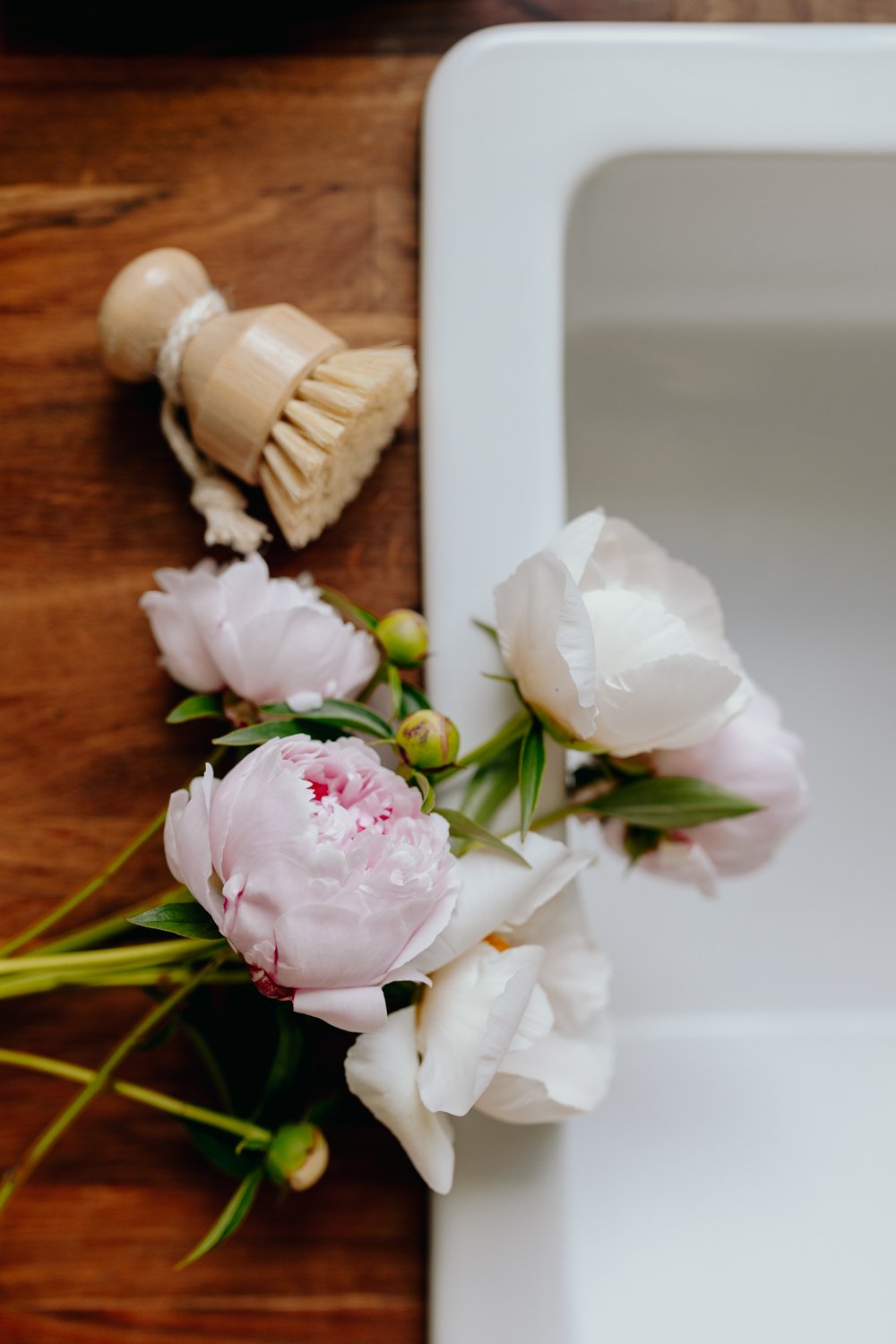BACKYARD GARDENING MADE SIMPLE
Preserving the Beauty of Peonies: Strategies for Prolific Blooms and Healthy Plants [Guide]
May is for three things; asparagus, rhubarb and peonies. These are the first true signs that spring is really here to stay after a long, cold and dark winter. Our pink double peonies live just outside my bedroom window, and in May I begin checking on them daily for signs of life. Almost overnight they can burst into a beautiful display of fragrance and color, ready for picking.
The Cottage Peach is reader-supported. When you purchase through links on our site, we may earn an affiliate commission at no additional cost to you. All opinions are our own.
May is for three things; asparagus, rhubarb and peonies. These are the first true signs that spring is really here to stay after a long, cold and dark winter. Our pink double peonies live just outside my bedroom window, and in May I begin checking on them daily for signs of life. Almost overnight they can burst into a beautiful display of fragrance and color, the many petaled blooms soon overrun with my least favorite garden visitor (ants).
Double peonies seem like they have hundreds of petals all packed in close together, and the denseness of them even in full bloom always amazes me.
We also have a huge patch of white single peonies that I am tempted to bury my face in every year. This plant is so well established now that we have more blooms than I even know what to do with at times. The single peonies are a lot more delicate, with five to ten thin petals bending off the pollen bearing stamen in all directions in a wild display that somehow feels chaotic and classic all at once. Just writing this I can practically smell them again!
Each spring I bring fresh cuttings inside and the diverse texture stands alone in a vase with no need to add fillers or greenery. But, these beautiful blooms are short-lived and leave me wanting more every time. Thankfully I have a trick for extending the life of my peonies and enjoying fresh cut peony flowers in my home up to a month after they would normally be blooming. But before we delve into that, let’s make sure you are set up for success in growing peonies of your own. That way, even if you do not have peony plants blooming in your garden this spring, you can get them in the ground come fall and save this post for next year.
Where do peonies grow?
Peonies are hardy to Zone 3 and grow well as far south as Zones 7 and 8. Peonies even relish cold winters, because they need chilling for bud formation.
How to grow peonies
If you’re wondering how to plant peonies, you’ve come to the right place! Peonies are most commonly grown from a bare-root tuber. While you can grow peonies from seed, it will take five to six years before they bloom, so generally you’ll be starting with a tuber. You’ll want to plant your peony tuber in an area that gets full sun, in well draining soil. They will rot in water logged soil. The most important thing about planting your peonies is orienting the tuber correctly in the hole. Peony tubers have a top! You should plant your peonies in late fall - September or October.
Space peonies 3 to 4 feet apart - they can get very big and bushy!
Dig down two feet to loosen the soil. Then backfill until your hole is only about 2 inches deep and place the tuber so that the “eyes” face upward and the roots are about two inches below the soil surface.
You can enrich sandy or heavy soil with compost and incorporate about one cup of bone meal into the soil, but it’s not necessary.
Water immediately after planting.
There are six peony flower types to choose from: anemone, single, Japanese, semi-double, double, and bomb. Peonies come in many shades of pink, purple, red, white, and yellow. I love to grow pink double peonies because they are so fluffy with all the extra showy petals! But a simple white peony is such a classic too.
A final note; choose your location wisely, because peonies do not like to be transplanted. They are unlikely to bloom for 2-3 years after transplant.
Grow peonies in pots
You can grow peonies in pots, but you’ll need a very large container with excellent drainage. The planting depth should be the same as when you are planting peonies in the ground - only about an inch or two below the surface. Peonies grown in pots should be allowed to almost dry out before watering. They will also need to be protected from deep freezes in the winter.
How tall do peonies grow?
There are two common types of peonies, so if you’re wondering how big peonies can grow, it’s important to know which type you’re looking at. Herbaceous peonies grow best in zones three through seven and can grow to be two to three feet tall and two to four feet wide. These are the typically bushy type peonies seen in most gardens. Tree peonies grow best in zones three through nine and resemble small shrubs, growing as tall as seven feet. We’re talking about herbaceous peonies in today's post, but let me know in the comments if you grow tree peonies in your yard!
How long do peonies take to grow?
Peonies are slow growers and can typically take up to three years to fully mature. If you grow tubers from an established plant you may see one or two blooms in the first year. Growing peonies from seed can take six or seven years and isn’t typically recommended. The older your peony plant is, the more bushy and bloom filled it will be.
How much sun do peonies need?
Peonies love the sun, although they are sensitive to extreme temperatures. Peonies grow best in areas with six to eight hours of direct sunlight. It’s also important to make sure you’re spacing your peonies at least 2 feet apart in order to increase air circulation around the plants and reduce the risk of fungal disease.
Do peonies attract ants?
While it’s a myth that peonies need ants in order to bloom it is true that peony buds secrete a sweet, sugary nectar that attracts ants. Scientists have yet to figure out the true purpose of this symbiotic relationship, but it’s fun to imagine the possibilities!
Should peonies be cut back in the fall?
Since peony plants start from tubers, you want them to store as much energy as possible underground over the winter. This is why you should always cut back your peony plants as close to the ground as possible in the fall after the foliage has completely died back or yellowed after a hard frost. This advice only applies to herbaceous peonies - tree peonies should be cut back immediately after they bloom.
Should you mulch peonies?
It’s not necessary to mulch established peony plants, but you can apply a thin layer of straw mulch in late fall on plants that are less than two years old.
How do you winterize peonies?
To winterize peonies, simply cut back to the ground. If the plants are less than two years old, you can add a thin layer of straw mulch to protect them when the ground freezes.
Should you deadhead peonies?
Cutting off your peony blooms or deadheading will allow your peony plant to redirect its energy into the roots and grow bigger. And with the tip below, you’ll want to cut off all your peony blooms right away so you can save them for later anyway!
How to make peonies last longer
Did you know that you can make your short-lived peony blooms last for a month or longer? Peonies are strongly associated with spring, but you can have fresh peony flowers into early summer with this trick. The key is timing your cuttings correctly and using cold storage. If we cut our peony blooms before they have a chance to open, then suspend their growth by convincing them to go dormant using cold temperatures, you can effectively pause their bloom cycle and restart it again when you want fresh flowers for your table in June or even early July.
Time your cutting perfectly: This is key. The bud should still be closed, but squishy and only slightly firm like a marshmallow. If your peonies aren’t white, the petal color should be showing through.
Cut the stem at a steep angle using your sharpest clippers just above a set of leaves.
Remove all of the leaves and place in a plastic Ziploc bag. You can wrap in a damp newspaper, Stasher bag if it’s large enough, or plastic wrap. But you’ll have to keep the newspaper damp at all times.
Place the bag in the coolest part of your refrigerator, close to the back.
When you're ready to use your flowers, take them out of the fridge and place in tepid water. As they warm back up, the petals will open revealing perfect fresh blooms! This can take a day or so.
The hardest part of this process is knowing when to pick the flowers. If you struggle with your blooms not opening or opening while still in the fridge, you’ve picked them at the wrong time. Keep an eye out over on Instagram as I’ll be sharing a post showing the correct stage for harvesting as soon as my peonies bloom this season!

![Preserving the Beauty of Peonies: Strategies for Prolific Blooms and Healthy Plants [Guide]](https://images.squarespace-cdn.com/content/v1/60e85024dc86d643da81c96a/4b2f4d11-b3bf-47b3-9c63-22245a84d175/Flowers+May+2022-6.jpg)





![The Power of Nature: How To Make Infused Oregano Oil for Your Health and Wellness [Recipe]](https://images.squarespace-cdn.com/content/v1/60e85024dc86d643da81c96a/1682625337753-AFI1M6MRRMDQ5CBNY2TX/unsplash-image-Fl2Ki3_GZIU.jpg)
![Make This Easy + Natural Botanical Hand Salve [Recipe]](https://images.squarespace-cdn.com/content/v1/60e85024dc86d643da81c96a/b57698b0-de70-4101-afaf-7af57788237d/Herbal+Face+Steam+Recipe+by+The+Cottage+Peach-1.jpg)